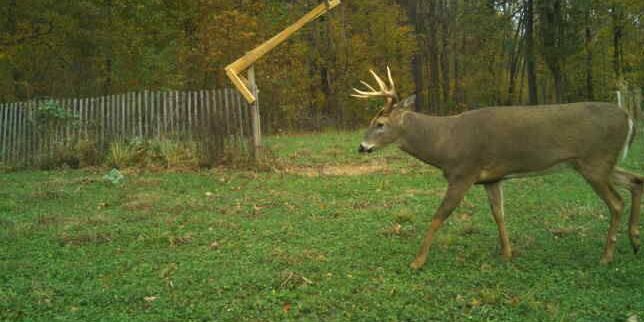Imagine owning a private whitetail hunting paradise with high ground and damp darker bottoms, with clumps of hardwood timber and small fields with seven-foot-tall warm-season grasses. The property has nut and fruit trees strategically placed ready to drop fall treats and a collection of food plots scattered around connected by travel corridors and lines of movement. Comfortable doe groups rest near food with bucks bedded deeper in the timber or thickets. Tree stands and ground blinds are set up to take advantage of the wind, weather, and time of the year. Hunting locations are accessible without bumping deer and available during the entire season without deer knowing they are being hunted. The habitat has various changes creating countless edges and diversity that allow more deer to live closer together without social stress. Deer move and feed during daylight and even mature bucks work scrapes midday in late October. Is this something you are interested in? Food, water, and cover, the recipe for happy whitetails right? Well, that’s what everyone says.
In this blog, I’m going to tell you the real story of what you need in order to find that piece of property to purchase to then turn into a private whitetail hunting paradise. Food, water, and cover is one set of things to consider. When looking for a property other vital important points to consider is the neighboring properties, the location of a dwelling, and the income potential of the property to offset some costs.

The hunting pressure on the neighboring properties is the single biggest factor in your hunting success and should be a consideration when thinking about your own piece of land. Unless you’re buying 1000+ acres, the neighbors are going to have a huge impact on your future success. Before buying a piece of real estate, Look at a map and learn. What are on your future borders? Is the property basically a square shape with about 4 neighbors or are there many smaller pieces creating many neighbors. Are you bordered by a state park where there won’t be any hunters or is it public ground that will be crawling with hunters? By stopping and talking to one of the neighbors you just might get a pretty good history of hunting pressure in the area. My personal property has dirt county roads on two of the four sides. A disadvantage to this is road travelers can see into certain parts of the property. Some of this can be dealt with through edge thickening but some of it is just a fact of life. The advantage to this is that the neighbors can’t sit on the property line in a tree stand. This typically isn’t an issue if you have a good relationship with them.
Are you planning to live on this land or will this be strictly a hunting/recreational property? If you plan to live on the property or stay there while hunting, you have to consider how this affects deer and deer movement. If the prevailing wind is from the southwest, you don’t want the cabin in the southwest corner. If the prevailing wind is blowing your scent into the center of the property you may run the deer off the property as soon as you arrive. Your absence and your presence on the property impacts deer. Our Indiana property has a residence in a barn and sits empty and quiet whenever we aren’t visiting the farm. We visit the farm a couple of times a year to work on habitat, plant food plots, set up trail cameras, and just relax. When I visit the property during the hunting season all of the sudden there are daily noises from human activity in the corner of our 77 acres where there hadn’t been any sounds at all for months. Screening and blocking through hinge cuts and warm-season grasses can be just the ticket for these sorts of problems. The wind and all the human smells will affect the property and needs consideration.

Money doesn’t grow on those trees on the property, but being able to use the property to offset the costs of owning it helps. Some sort of an annual income is a great way for the property to help pay for itself even if all it does is cover your yearly property taxes. If the property has commercially farmed acres it’s probably got an annual income. check the history of the income generated from these tillable acres. Tillable acres have benefits to your wildlife, deer specifically, during certain months out of the year. Corn and soybeans are pretty common commercially grown crops in the Midwest. Beans are a fantastic food source while they are green and growing. Corn creates cover for a few months and some late season food in the way of waste grain left in the field after harvest but both crops leave stagnant open ground for a big portion of the year.
Another option with tillable acres is to convert the acres into some sort of government wildlife program like a Conservation Reserve Program (CRP) or another similar option. Government programs typically have an annual income similar to that of a commercial agriculture crop. Tillable acres converted into the CRP program provide year-round cover and browse. Before buying the property check to see what conservation programs are available and the requirements to enroll in them. Illinois for example requires that you own the property for one year before you are eligible to enroll it. If the property has a mature stand of hardwoods another potential source of income is from logging. By consulting a forester or contacting a tree buyer you may realize the property has a sizable amount of harvestable timber. Depending on the current markets this may lead to a sizable paycheck. I know a guy who bought a property and logged it right away. His share of the timber harvest was close to the 20% down required to buy the property. There are also government programs geared towards eradicating invasive species of plants, shrubs, and trees on the property. If doing the eradication work yourself, this could well be another sizable paycheck and yet another dent in the principle of your property costs.

When buying a whitetail hunting property, the neighboring properties, the location of living quarters, and income generation should seriously be considered before writing up a purchase offer. Your future neighbors are the biggest single factor affecting your future management. The relationship of a dwelling to the prevailing wind is vital to keeping deer within property boundaries and an income from the property makes for a smart investment and typically helps improve the habitat in some way. So save your money, do your research and prepare for one of the most rewarding investments you’ll ever make.
By: Phil Lincoln, Owner of The Habitat Guys LLC, Fairbanks Indiana
Phil’s Episode on Habitat Podcast –> https://bit.ly/3cUETwe

